RARE! WWII 1943 New Guinea Campaign 8th Photo Reconnaissance Squadron (5th Air Force) Heavily Used BONGA Combat Aerial Photo Map
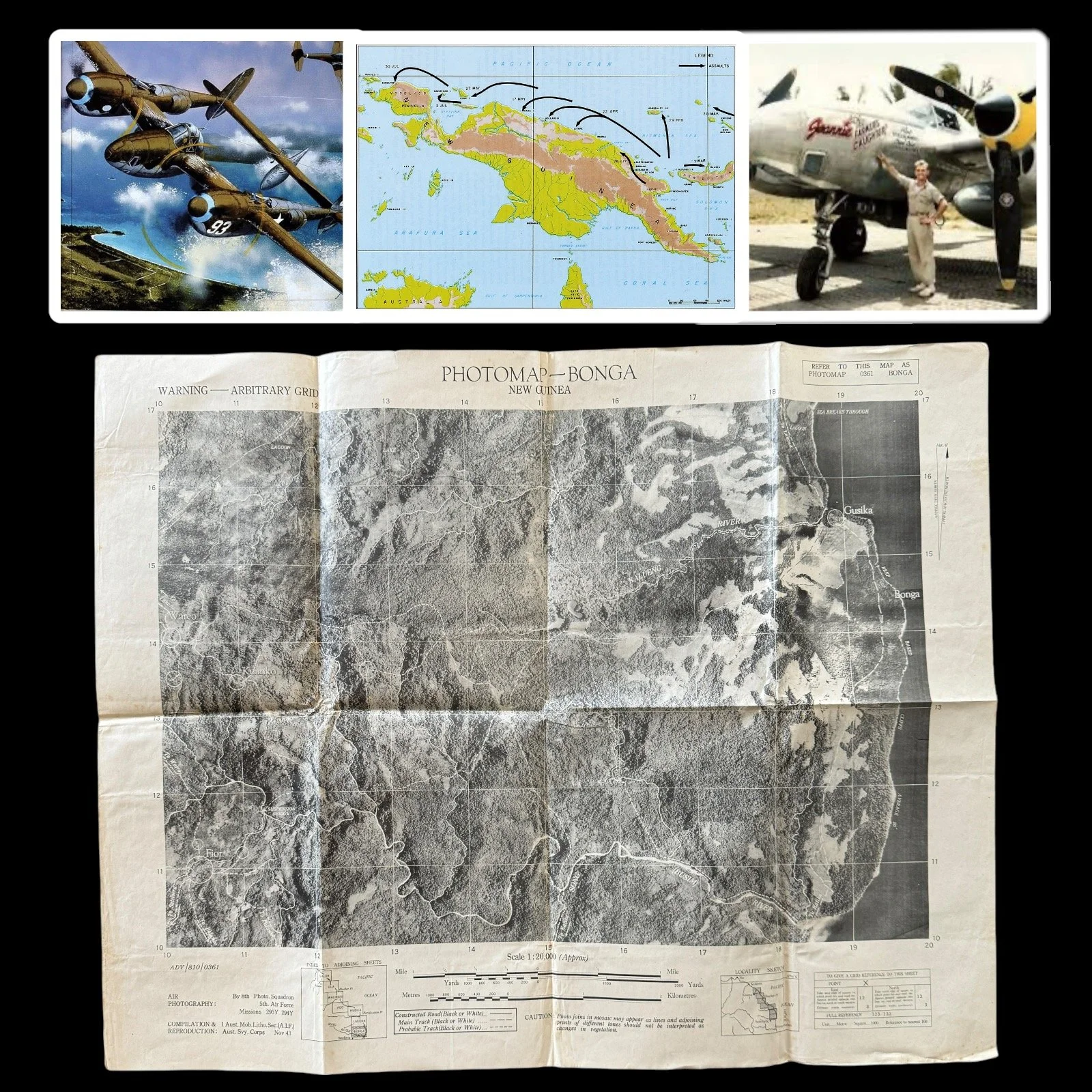
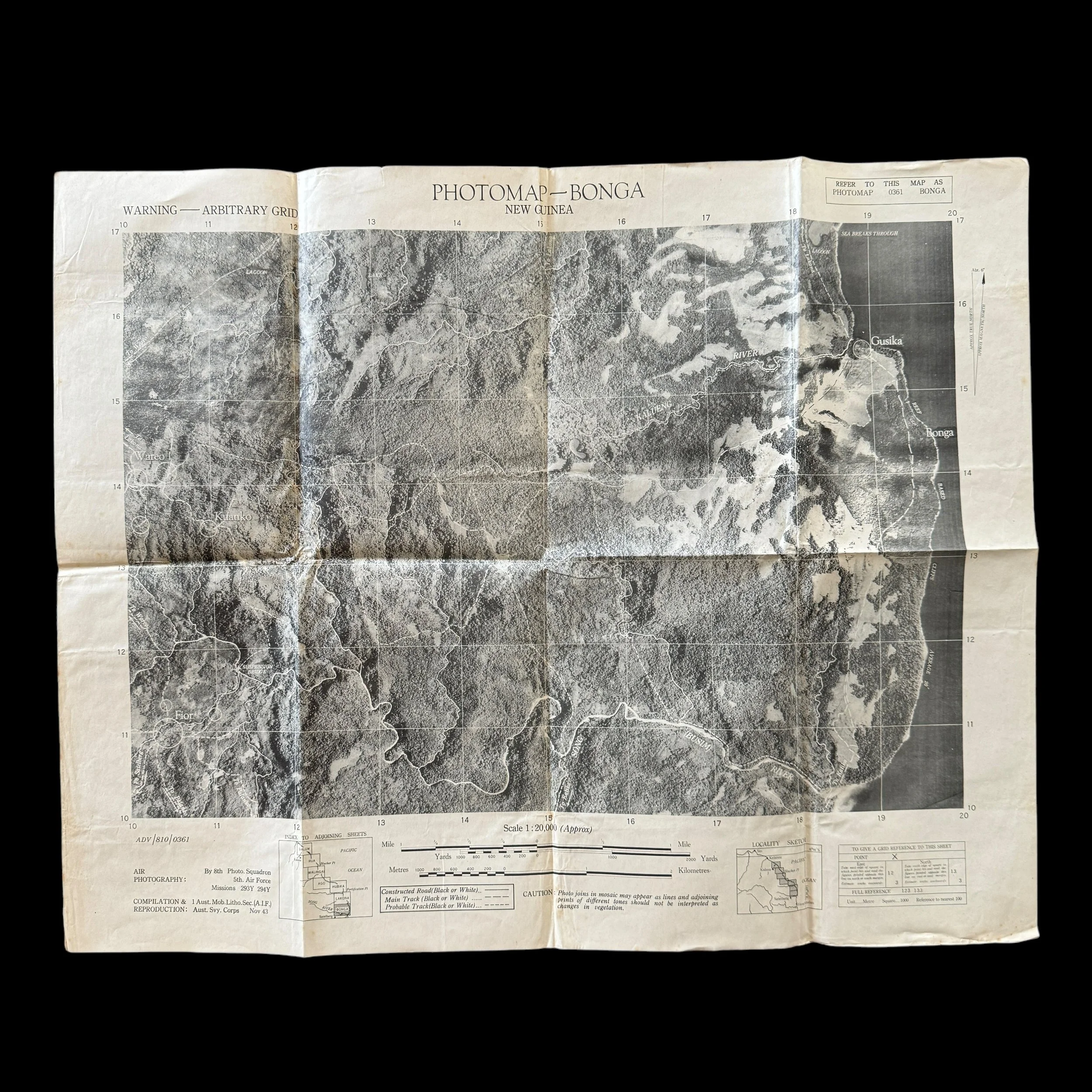

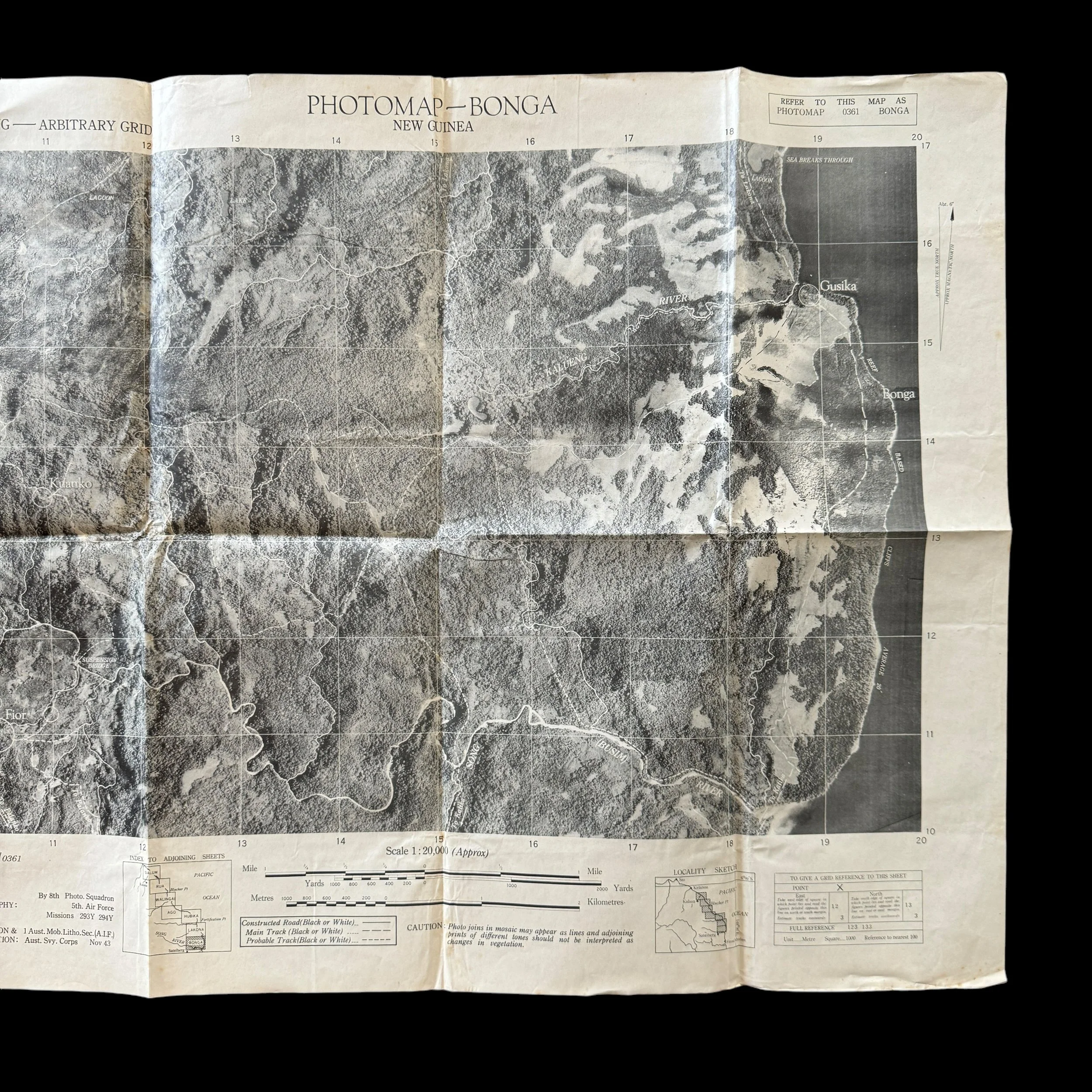
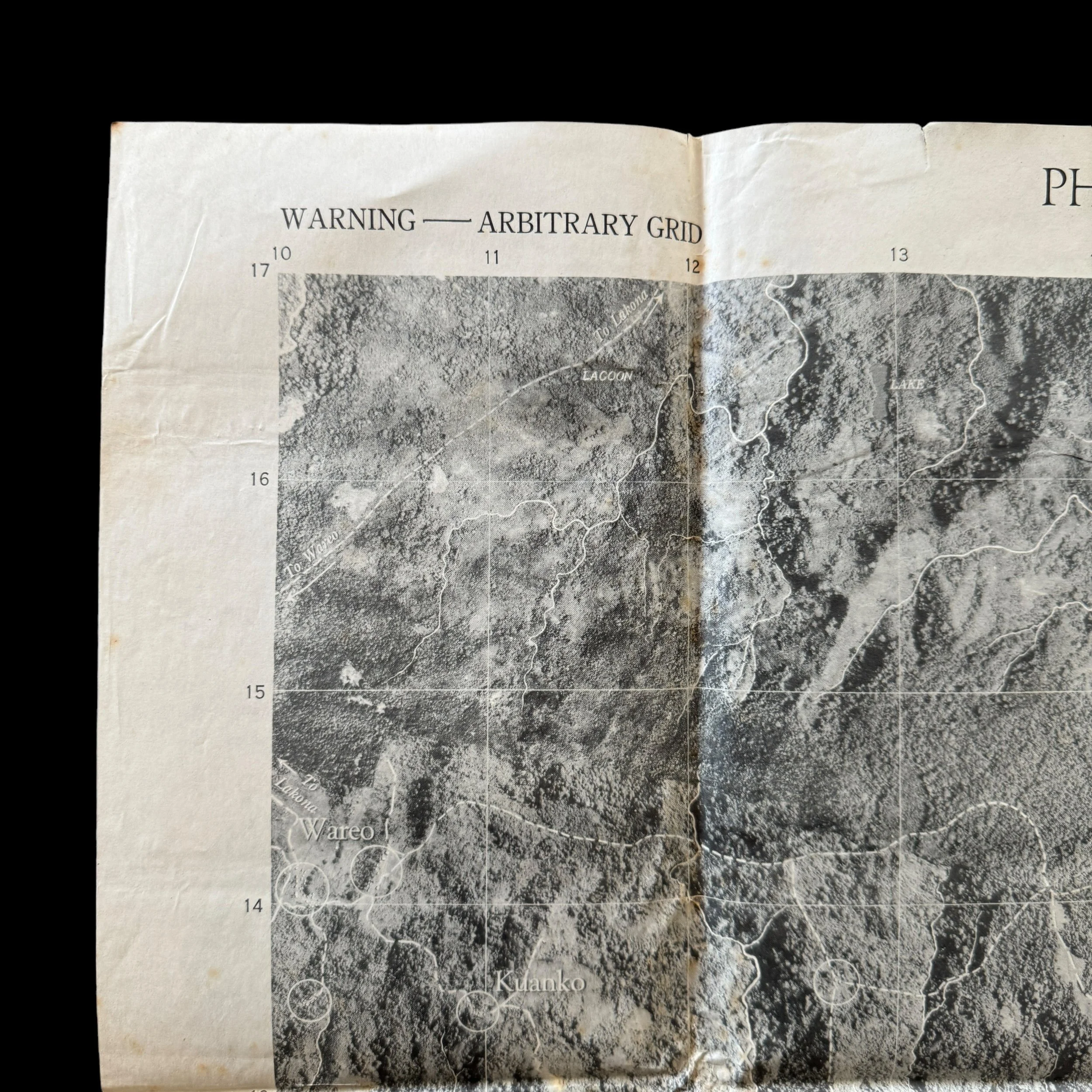

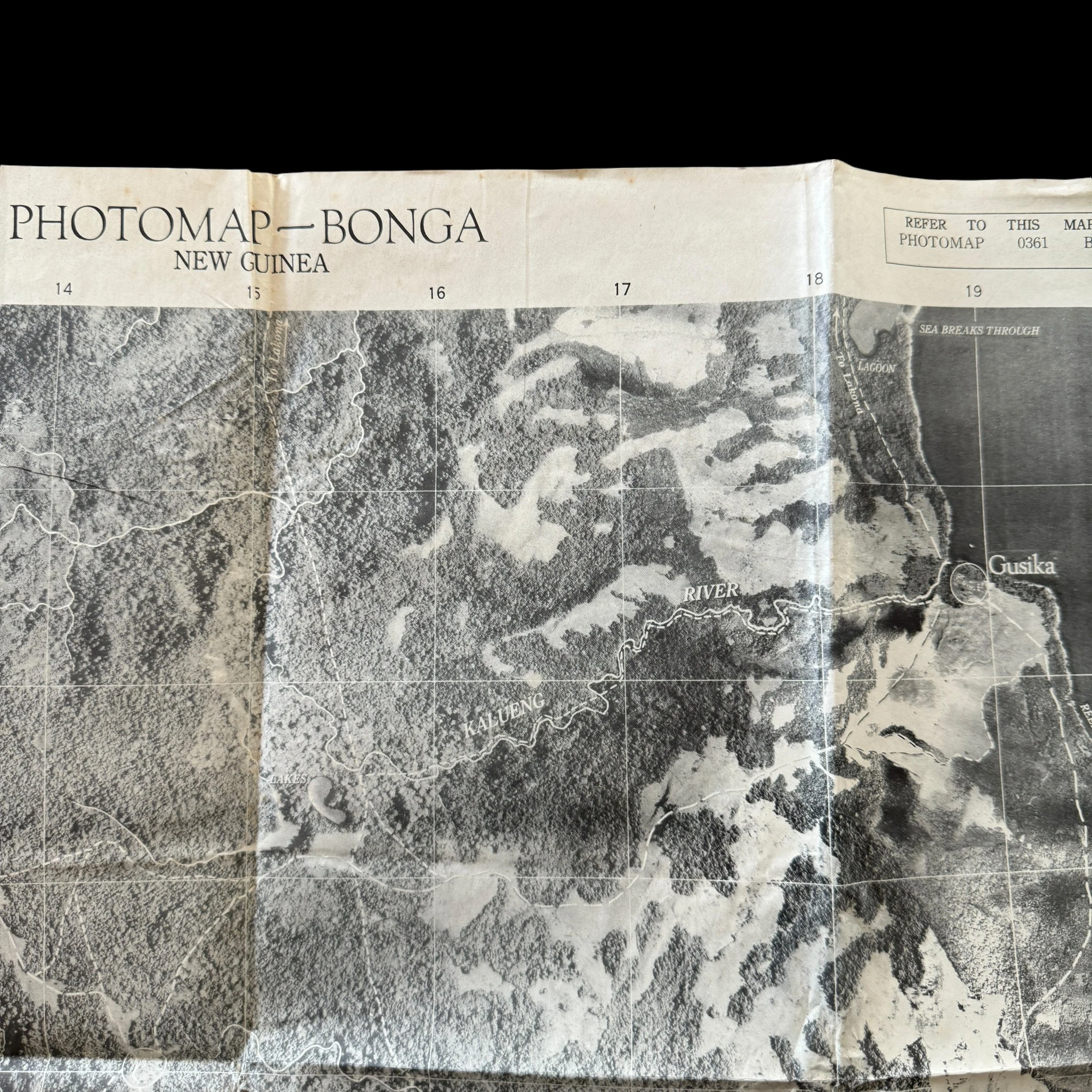



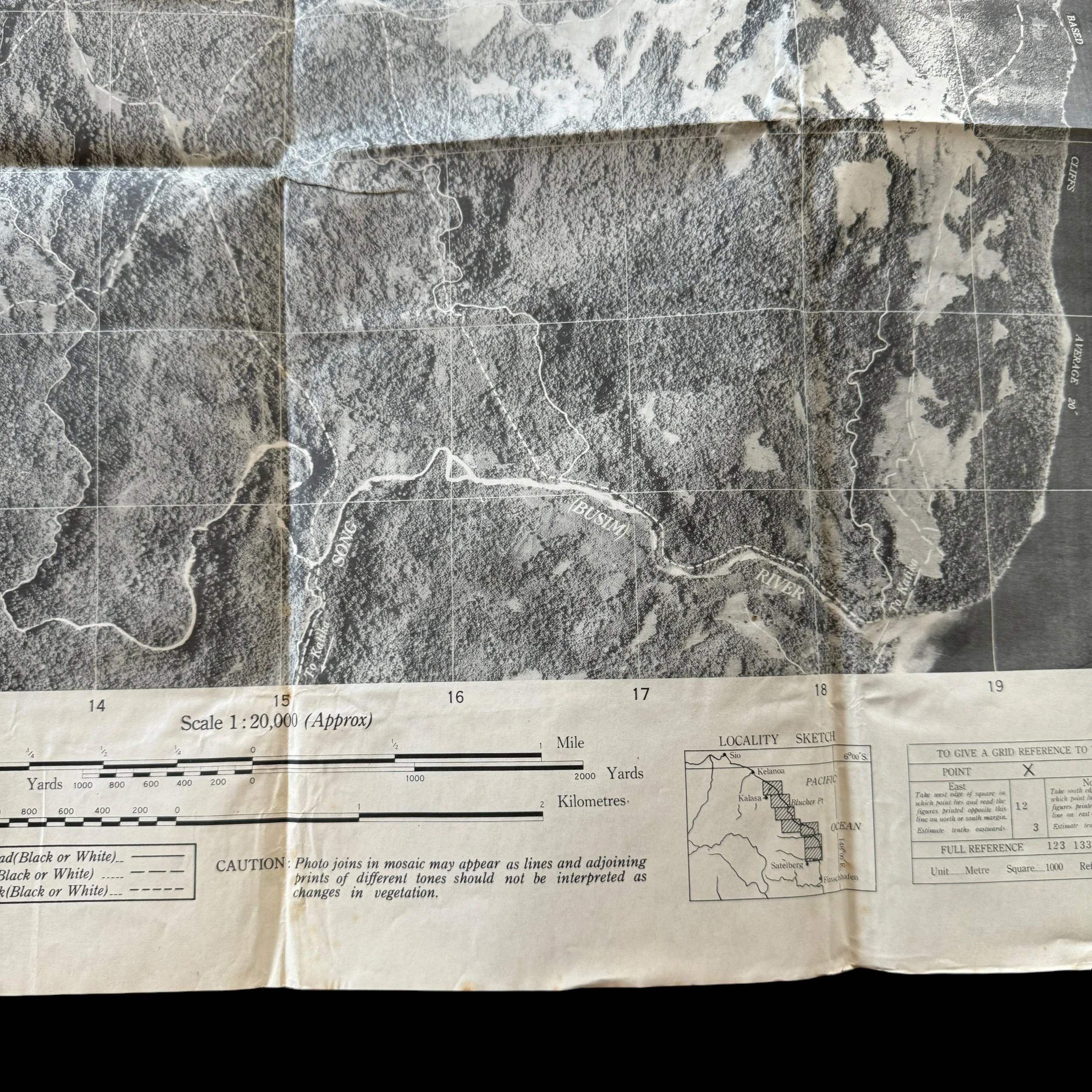

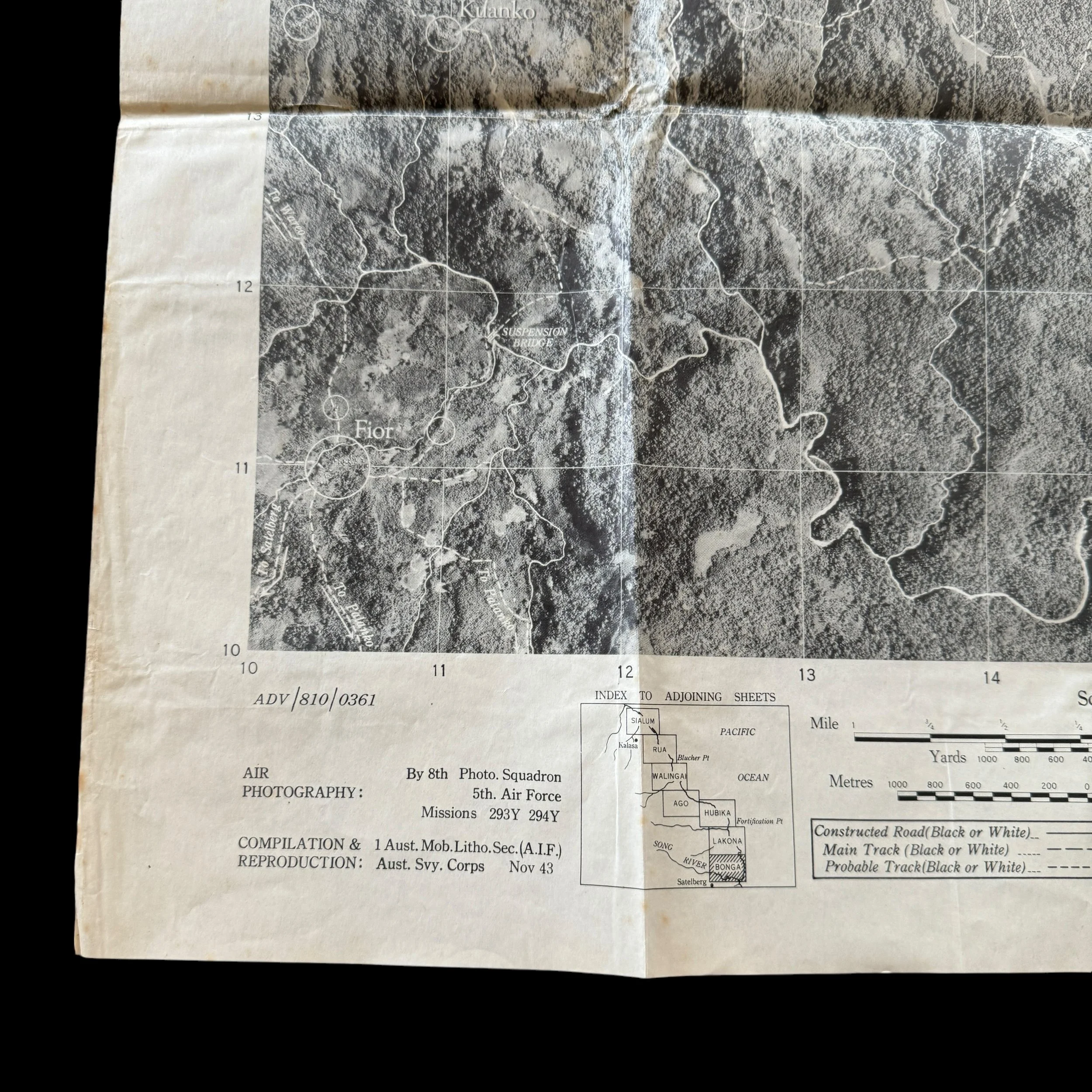


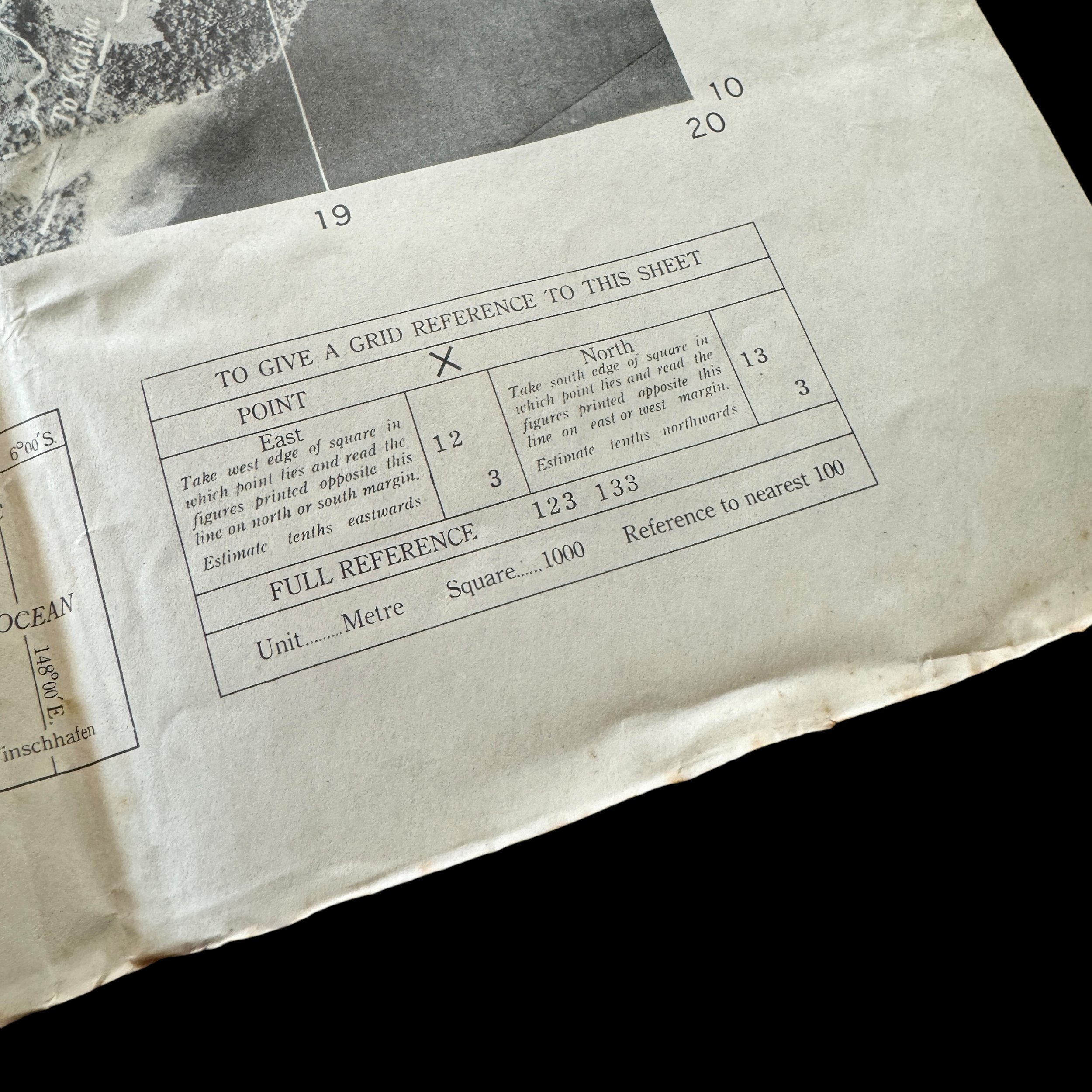

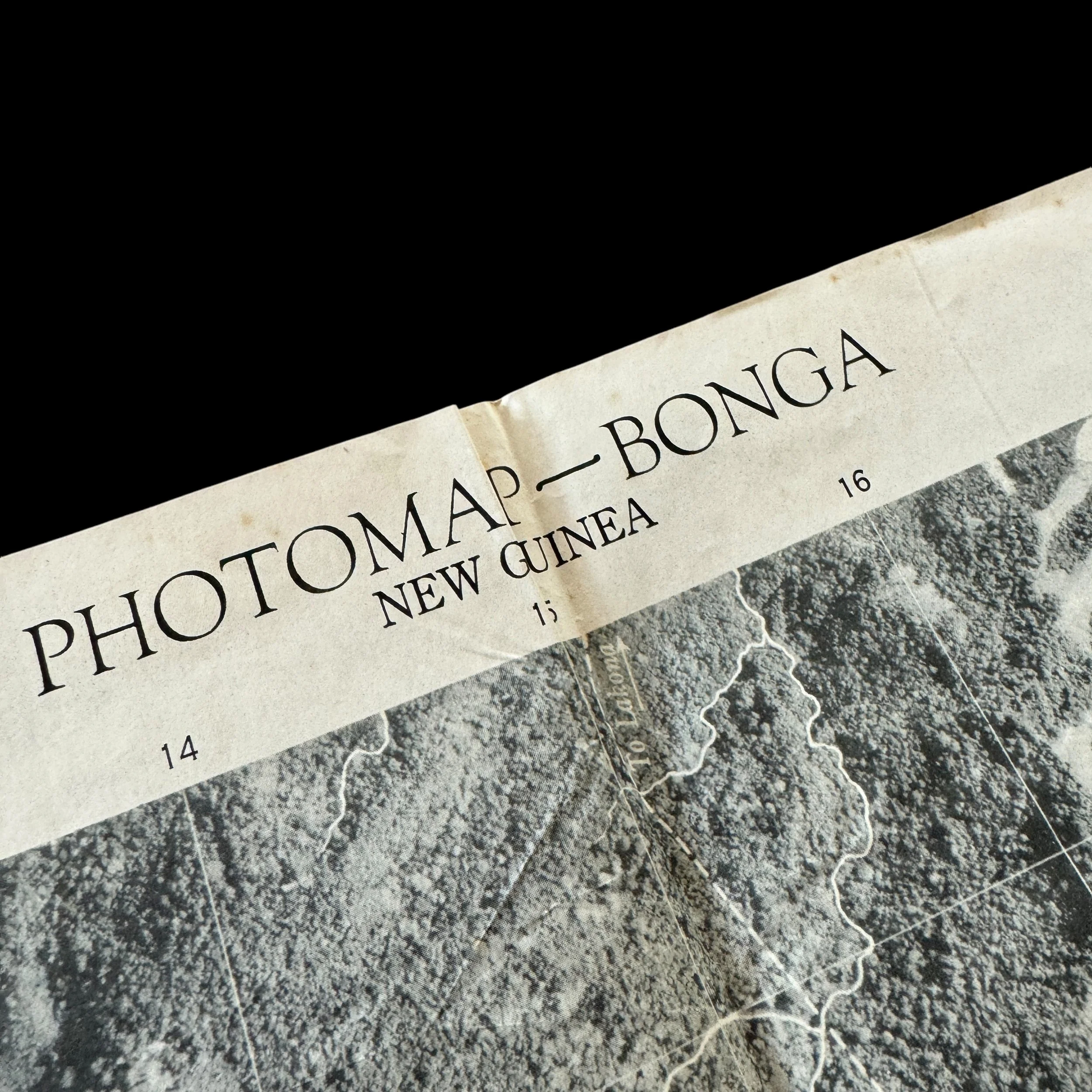



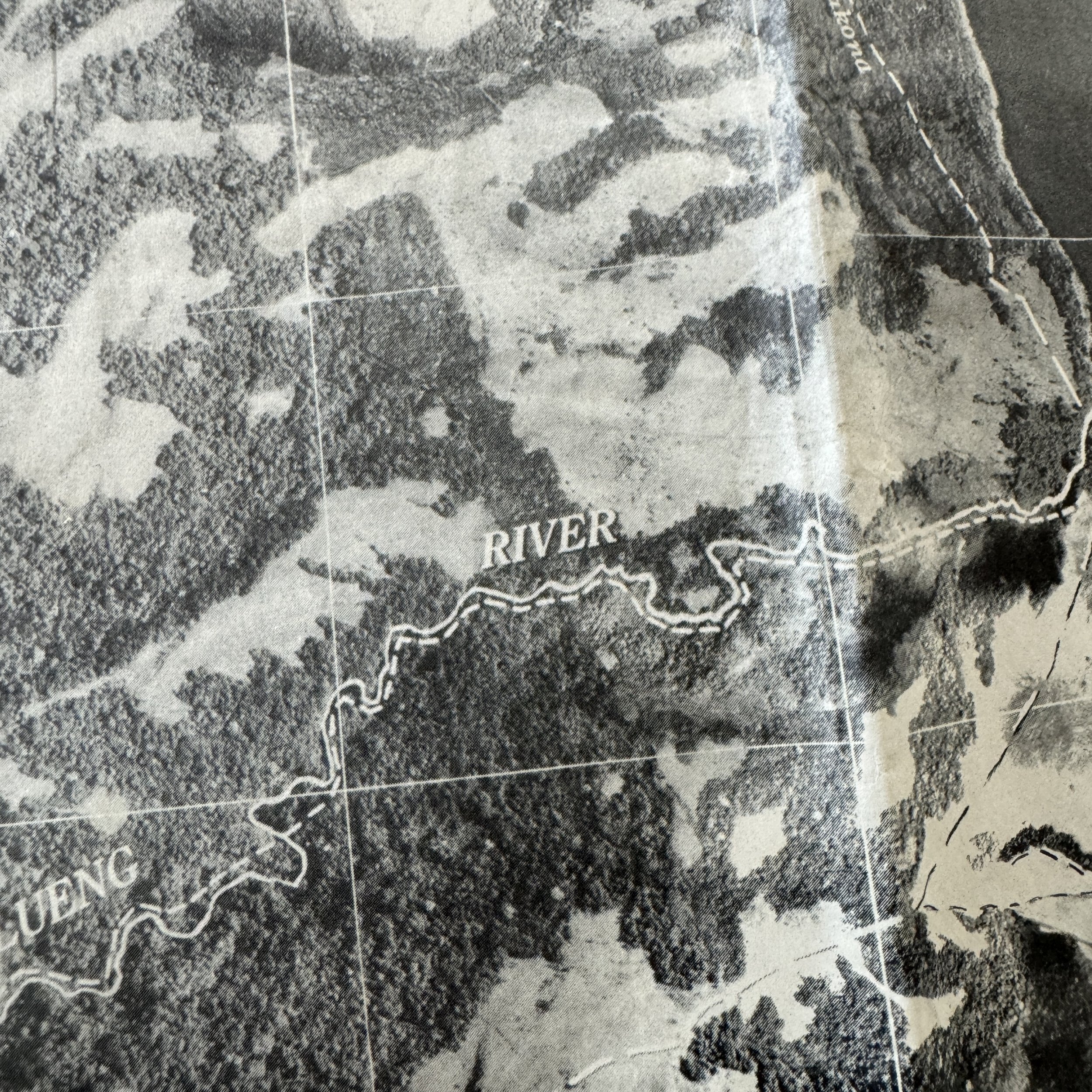
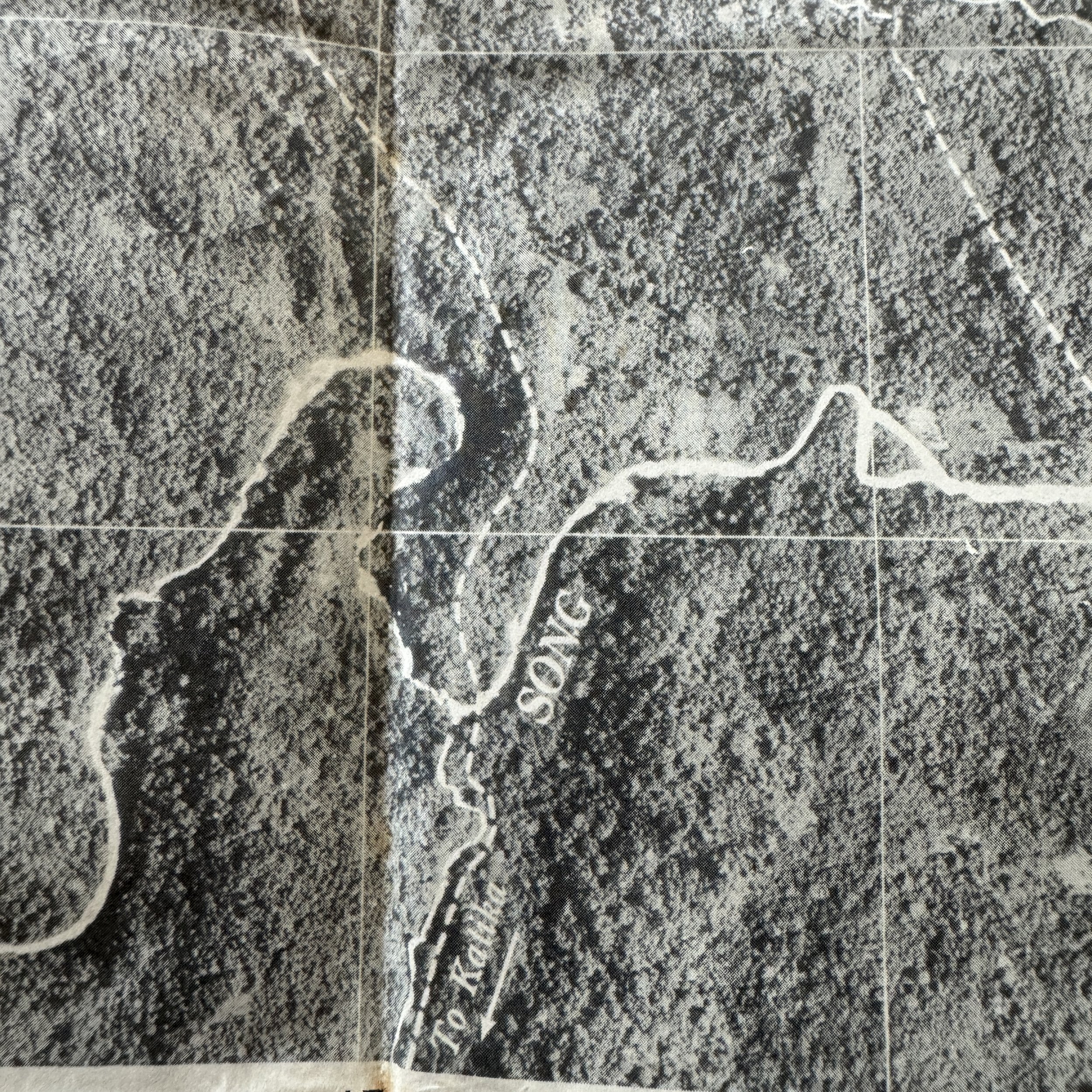


RARE! WWII 1943 New Guinea Campaign 8th Photo Reconnaissance Squadron (5th Air Force) Heavily Used BONGA Combat Aerial Photo Map
Comes with a hand-signed C.O.A.
*This New Guinea combat map is a part of a larger 8th Photo Recon Squadron bring-back collection of TYPE-ONE mission photographs (the same used to make these combat maps) as well as original Allied combat maps used during the New Guinea campaign.
Size: 18 × 23 inches
This extremely rare and museum-grade Pacific Theater WWII artifact is an original 1943 dated and heavily combat-used New Guinea photomap that was created using aerial photo reconnaissance mission photographs by the infamous 5th Air Force - 8th Photo Reconnaissance Squadron (Eight Ballers).
The 8th PRS, also known as the 8th Photo Reconnaissance Squadron, earned a renowned reputation for its exceptional service during campaigns across various regions including the East Indies, Japan, China, Papua, Guadalcanal, New Guinea, Northern Solomons, and Bismarck.
The 8th Photographic Reconnaissance Squadron (8th PRS) operated under the U.S. Army Air Force (USAAF), specifically part of the 5th Air Force and the 6th Photographic Reconnaissance Group (6th PRG). Referred to as the 8th Photographic Squadron, 8th Photo Recon Squadron, or 8th Photo Recon, the unit was initially outfitted with the F-4 Lightning, a specialized photographic reconnaissance variant of the P-38 Lightning. Camera equipment was installed in the nose section in lieu of traditional armaments. Conducting missions above Japanese-held territories and airfields, the squadron captured vital imagery utilized in the creation of aerial maps and target intelligence for subsequent combat operations. These reconnaissance flights were inherently perilous, with pilots often flying solitary missions through adverse weather conditions and challenging navigation circumstances. While over target areas, pilots maintained a steady flight path at lower altitudes to ensure high-quality photographic results, braving risks such as anti-aircraft artillery and potential interception by enemy planes. In later operations, F-4s received protective escort by armed P-38 Lightnings to enhance their defensive capabilities.
________________
Bonga
Bonga became a focal point for Allied forces after they landed at Scarlet Beach near Finschhafen in September 1943. As Australian troops advanced towards Bonga, the Japanese defenders, deeply entrenched in the jungle and fortified by natural terrain, resisted fiercely. Bonga itself, surrounded by dense forest and challenging terrain, presented severe logistical challenges. The Allies struggled to transport supplies, and the harsh conditions took a heavy toll on the soldiers, who endured intense heat, disease, and scarcity of resources. The fighting at Bonga was brutal and unrelenting, with each side determined to control this pivotal point on the advance towards Finschhafen and Sattelberg, crucial for securing the entire Huon Peninsula.
Gusika
Further south of Bonga, Gusika served as another critical point in the campaign. The battle for Gusika intensified as Australian forces moved down the coast in an attempt to cut off Japanese supply lines and prevent reinforcement. The area around Gusika was particularly perilous due to its dense jungle, swamps, and rivers, which hindered movement and added layers of difficulty to the combat operations. Japanese forces constructed bunkers and defensive positions throughout the area, forcing Allied troops to engage in labor-intensive clearing operations. Despite these obstacles, Australian forces pushed forward, gradually dismantling Japanese defenses through tenacious jungle warfare, often engaging in close-quarter combat where visibility and lines of sight were severely limited.
Kaeung River
The Kaeung River, snaking through the dense jungles of New Guinea, was another significant geographical feature that influenced the New Guinea campaign. The river acted as both a natural barrier and a supply route for the Japanese, who took advantage of its complex terrain to fortify their positions. Allied forces sought to control this area to disrupt Japanese movements and cut off their resources. Crossing the Kaeung River was an arduous task; Australian and U.S. engineers built makeshift bridges under fire and struggled against rising water levels and treacherous riverbanks. Skirmishes along the Kaeung River were frequent, with the dense vegetation offering ample cover for ambushes. Securing this river was essential for the Allies as they sought to move westward, establishing supply routes and eliminating Japanese footholds in the region.
Wareo
The fighting around Wareo was a key aspect of the campaign, especially following the capture of Finschhafen. Wareo, situated on high ground, held strategic importance due to its location and topography, providing a commanding view over the surrounding area. Japanese forces fortified Wareo extensively, preparing for a last stand to delay the Allied advance. The terrain around Wareo, marked by steep ridges and thick jungle, made any advance slow and exhausting. Australian forces launched a series of assaults on Wareo in late November 1943, enduring heavy resistance and treacherous conditions. The battle for Wareo involved intense artillery bombardments, close-quarter combat, and relentless jungle skirmishes. Ultimately, the fall of Wareo marked a turning point in the Huon Peninsula campaign, opening the way for further Allied advances and disrupting Japanese defensive lines.
Kuanko
Kuanko was the site of some of the final battles in the New Guinea campaign, marking the culmination of the Allies' strategic objectives on the Huon Peninsula. By the time Australian troops reached Kuanko, the Japanese defenders were significantly weakened and demoralized, though they still put up a fierce resistance. The battle for Kuanko involved not only infantry assaults but also coordinated support from artillery and air strikes to overcome entrenched Japanese positions. Australian forces had learned from earlier encounters and employed coordinated maneuvers to outflank and encircle Japanese units. The capture of Kuanko allowed Allied forces to secure a foothold in the area, effectively sealing the Japanese fate on the Huon Peninsula and signaling the Allied dominance over the region.
________________
During World War II, combat photomaps were a vital tool for planning and executing military operations, particularly in challenging terrains like those found in the South Pacific, including New Guinea. Photomaps were created using aerial reconnaissance photographs combined with traditional cartographic techniques, providing highly accurate and detailed visual maps of terrain, structures, vegetation, and potential enemy positions. These maps were especially important in areas like New Guinea, where dense jungles, rugged mountains, and poorly charted territories made traditional navigation and planning extremely difficult.
The Strategic Importance of Photomaps in New Guinea
New Guinea was a key battleground in the Pacific Theater, as both Allied and Japanese forces sought control over the region due to its strategic proximity to Australia and critical supply routes. The dense jungle terrain and steep mountains made conventional maps inadequate, so photomaps became indispensable. These maps gave Allied forces a strategic advantage, as they could accurately pinpoint natural obstacles, river crossings, potential landing zones, and enemy fortifications—information that was crucial for planning ambushes, supply drops, and coordinated assaults.
In New Guinea, Allied forces needed to identify and navigate through uncharted jungle terrain, plan airstrikes, and locate Japanese supply lines and bases hidden in natural cover. Photomaps allowed military leaders to accurately identify these critical areas, providing vital intelligence for tactical planning. Allied forces used photomaps extensively in key operations, such as the capture of the Kokoda Track, the Buna-Gona campaign, and the Battle of Wau, where knowledge of terrain often determined the outcome of engagements.
The Creation and Use of Photomaps
Photomaps were produced by taking multiple high-resolution aerial photographs, often from reconnaissance planes flying at high altitudes. These photographs would then be stitched together to create a detailed composite of the area. The accuracy of photomaps depended heavily on the quality of the photographs and the skill of the cartographers who aligned them. In New Guinea, challenging weather conditions, such as tropical storms, heavy cloud cover, and mountainous terrain, complicated aerial photography, making photomap creation a demanding task that required patience and precision.
Once photomaps were created, they were distributed to field commanders, pilots, and ground troops. These maps allowed soldiers to plan their approach routes, identify enemy defenses, and navigate difficult terrain without the need for detailed topographic maps, which often weren’t available or were outdated. For example, in the Battle of Buna-Gona, photomaps enabled Allied forces to pinpoint Japanese bunkers, hidden artillery positions, and supply trails that would have been invisible in standard maps or field reports. This level of detail was critical in planning precise airstrikes and ground movements, which were essential in securing victory in such a complex environment.
Impact on Air and Ground Operations
Photomaps were especially useful in coordinating air and ground operations. The Royal Australian Air Force (RAAF) and the United States Army Air Forces (USAAF) used photomaps to identify bombing targets, enemy fortifications, and supply depots. Bombers could plan their approach routes and targeting patterns based on detailed topography provided by photomaps, reducing the risk of collateral damage and improving the success rate of airstrikes. During the Battle of Wau, for instance, photomaps allowed Allied pilots to navigate through dense cloud cover and steep mountain ranges to deliver much-needed supplies and reinforcements to Allied forces engaged in battle.
For ground forces, photomaps were invaluable in planning amphibious landings and troop movements across challenging terrain. Troops could avoid natural barriers such as swamps, cliffs, and rivers, and identify more accessible routes through dense jungle areas. This knowledge allowed for more efficient movement and positioning of forces, helping troops to maintain the element of surprise in their engagements with Japanese forces.
In amphibious operations, such as those around Lae and Salamaua, photomaps helped commanders choose landing sites that offered cover and proximity to key objectives. The maps provided enough detail to allow for effective coordination between infantry, artillery, and air support units, maximizing the efficiency of Allied assaults on Japanese-held positions.
Legacy and Influence
The use of photomaps in New Guinea marked a turning point in military cartography, establishing photoreconnaissance as a critical component of modern warfare. These maps set a new standard for military intelligence and planning, showcasing the potential of aerial reconnaissance to provide real-time data and highly accurate visual information. The success of photomap-based operations in New Guinea helped influence the development of satellite imagery and geospatial intelligence systems used in modern military and civilian applications.